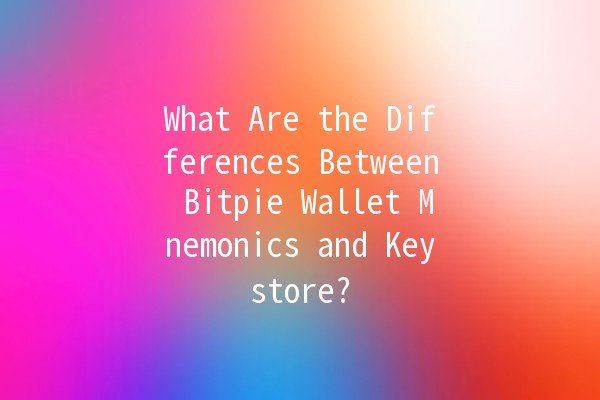




In the world of cryptocurrency wallets, security is a paramount concern. Two popular methods of securing your digital assets involve the use of mnemonics (or seed phrases) and Keystore files. While both serve the essential purpose of protecting your cryptocurrencies, they do so in different ways with their distinct characteristics. This article explores the differences between Bitpie wallet mnemonics and Keystore files, providing insights into how each method works, their pros and cons, and tips on which one might be best for you.
A mnemonic, often referred to as a seed phrase, is a series of words used to generate your cryptocurrency wallet. It is typically a 12 to 24word phrase derived from a special algorithm, meaning that anyone who possesses this mnemonic can access the wallet and its funds. In the case of Bitpie, a widely used cryptocurrency wallet, this seed phrase is vital for wallet recovery.

When you create a wallet in Bitpie, the application generates a mnemonic phrase for you. This phrase is a humanreadable way to store your wallet’s private keys. The process goes like this:
Pros:
Easy to Remember: Mnemonics are designed to be easy for humans to remember.
Wallet Recovery: They provide a seamless way to recover wallets.
Universal Compatibility: Most wallets support mnemonic phrases.
Cons:
Physical Theft Risk: If someone gets a hold of your mnemonic phrase, they can access your funds easily.
User Error: Mistyping or misremembering parts of the mnemonic can lead to loss of access.
A Keystore is essentially a file that contains your encrypted private keys along with other information necessary to access your cryptocurrency wallet. In the context of Bitpie, this file offers another layer of security for your cryptocurrency assets.
Creating a Keystore file involves the following steps:
Pros:
Enhanced Security: The private key is encrypted, adding an extra layer of protection.
Password Protection: Requires a password to access, which can bolster security.
Cons:
Complexity: The use of passwords and encryption can confuse some users.
Loss of Access: If you forget your password, you may no longer be able to access your wallet, even if you have the Keystore file.
Mnemonics: Stored as a series of words that a user must safeguard, often handwritten or stored in a password manager.
Keystore: Stored in a digital format as an encrypted file.
Mnemonics: Can be used directly to recover a wallet, even across different wallet platforms.
Keystore: Requires the software that understands how to decrypt the private key from the file using the password.
Mnemonics: Security is solely dependent on how well the user keeps the phrase private.
Keystore: Helps protect against unwanted access through encryption, but requires management of another piece of information—the password.
Mnemonics: Preferable for users who require simple wallet recovery processes, especially on different wallets.
Keystore: Ideal for users focusing on highlevel security, willing to manage passwords and encrypted files.
Mnemonics: Generally more userfriendly, perfect for beginners.
Keystore: May require more technical understanding, which could be challenging for novice users.
Explanation: Always keep multiple secure backups of your mnemonic phrases and Keystore files. This ensures that you can recover your wallet in case of device loss.
Example: Store a copy in a secure password manager and another on an encrypted USB drive.
Explanation: For your Keystore encryption, use complex passwords that include a mix of characters, numbers, and symbols. Avoid using easily guessable information.
Example: Instead of using "crypto123", opt for phrases like “L0ve2Tr4v3l&Crypt0!”.
Explanation: Adding an extra layer of security can protect your wallet from unauthorized access. Use services that support twofactor authentication.
Example: If using a web wallet, enable twofactor authentication via an app like Google Authenticator.
Explanation: The world of cryptocurrency is fastchanging. Keeping updated on security practices can help you mitigate potential risks.
Example: Following reliable cryptocurrency news outlets can help you stay informed about emerging threats and best practices.
Explanation: If you’re part of a community or group that deals with cryptocurrencies, share your knowledge about maintaining security and utilizing wallets effectively.
Example: Conduct a workshop or share articles in your online community to help others understand the importance of mnemonics and Keystore.
Yes, many wallets allow you to generate both types of security measures. Using both can enhance security levels and allow for easier recovery options.
If you haven’t backed up your mnemonic phrase, unfortunately, you may lose access to your wallet. It is vital to write it down and keep it secure right from the start.
While it's convenient, storing mnemonic phrases on your phone can expose them to risks. Consider trusted password managers or physical copies for security.
To recover your wallet, simply navigate to the wallet app and select the option to restore from a seed phrase. Enter your mnemonic exactly as provided.
Unfortunately, forgetting the password means you will not be able to access your wallet. This reinforces the need to use memorable passwords and possibly password managers.
Both can be at risk if not secured properly. Mnemonics can be stolen if someone gains access to their physical copy, while Keystore files can be hacked if the device they are stored on is compromised.
By evaluating the unique aspects of Bitpie wallet mnemonics and Keystore files, users can make informed decisions on which method suits their security needs best. Staying educated and vigilant about these tools is essential in safeguarding your cryptocurrency assets in an everevolving digital landscape.